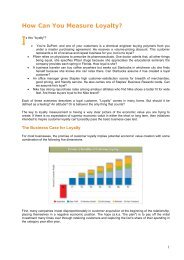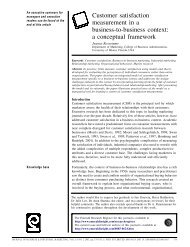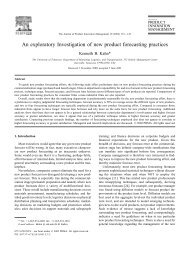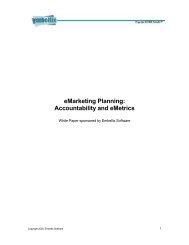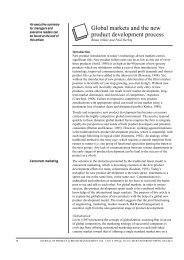CUSTOMER LIFETIME VALUE, CUSTOMER PROFITABILITY, AND ...
CUSTOMER LIFETIME VALUE, CUSTOMER PROFITABILITY, AND ...
CUSTOMER LIFETIME VALUE, CUSTOMER PROFITABILITY, AND ...
Create successful ePaper yourself
Turn your PDF publications into a flip-book with our unique Google optimized e-Paper software.
For the reasons stated above, the definition connects the value in CLV to the finance<br />
concept of present value. In so doing, we are consistent with other definitions of<br />
customer lifetime value that mention “discounted,” “present value” or “taking into<br />
account the time value of money.”<br />
In keeping with the principles of finance, the term “cash flows” is used to refer to<br />
what gets discounted. Most other descriptions of CLV do not use the term “cash flow.”<br />
(Pfeifer and Carraway (2000) and Berger and Nasr (1998) are notable exceptions.)<br />
Instead, they tend to spell out components of cash inflows and outflows that are attributed<br />
to a typical customer relationship. We use cash flow as the most useful term here and<br />
leave it to the user to add the necessary specificity (i.e., to decide what are the specific<br />
cash inflows and outflows attributed to the relationship in question).<br />
Examples of descriptions of CLV that would not be totally consistent with our<br />
definition include those put forth by Jain and Singh (2002), Niraj, Gupta, and<br />
Narahimhan (2001), and Hughes (1997) that all use “net profit.” We say this because net<br />
profit can account for costs that are not cash flows (e.g., depreciation on a fleet of<br />
delivery trucks). There are numerous other examples where a cost is not a current or<br />
future cash flow (see Brealey et al., 1995). So even though customer cash flows and<br />
customer profits will often be close, we prefer to allow for the cases where they are not.<br />
In addition, both the finance and accounting disciplines assert that only cash flows (and<br />
not arithmetic profit numbers) have a time value ascribable to them.<br />
Indeed, the idea that cash flows can sometimes be different from customer profits<br />
was recognized by Reichheld: “First, to find the value of new customers, you have to<br />
know the annual profit pattern (or cash-flow pattern, if cash flow differs significantly<br />
from profits) that customers typically generate through the years.” (1996: 50). We agree<br />
with Reichheld that it is always correct to discount cash flows and that cash flows from<br />
customers may not differ significantly from customer profits. To reiterate, we choose to<br />
use “cash flow” in our definition so that it will always be correct and to highlight an<br />
important distinction between CLV and CP.<br />
11




